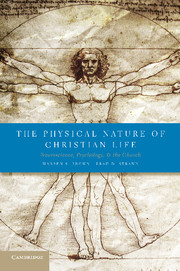Part I - Human Nature as Physical
Published online by Cambridge University Press: 05 July 2012
Summary
PROSPECT
We begin our exploration into the implications of a more wholistic and embodied understanding of persons for Christian life and the church in Chapter 2. We first describe briefly and thus somewhat simply the philosophical, historical, and theological background of body-soul dualism. In evaluating this view of human nature, it is important to know where it came from. Thus, we give a short history of the philosophical origins of body-soul dualism. We argue that the origins of body-soul dualism are mostly in the philosophy of Plato, with contributions and elaborations by St. Augustine in early Church history, and by René Descartes during the Enlightenment. We also argue that body-soul dualism is not the view of the Bible. Along with many biblical scholars, we believe that body-soul dualism has been taken as an a priori premise and read into scripture, rather than being the view we learn from scripture. Historically, dualism has also had a strong influence on the church in the form of the heresy of Gnosticism fought by the early church fathers. However, versions of Gnostic spirituality have hung around the church throughout the centuries, including a strong influence of this form of spirituality in modern religious life.
- Type
- Chapter
- Information
- The Physical Nature of Christian LifeNeuroscience, Psychology, and the Church, pp. 11 - 12Publisher: Cambridge University PressPrint publication year: 2012



